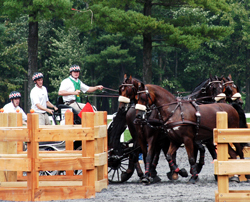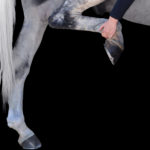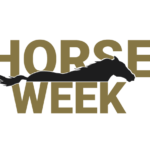[/caption]

Gladstone, N.J., June 20, 2005 — The dateline on this postcard is a little misleading, because it doesn’t tell the whole story. True, I spent three days at the U.S. Equestrian Team Foundation’s Gladstone Training Center watching the U.S. Equestrian Federation’s dressage championships, but then I traveled an hour south to Colts Neck for the Beacon Hill Equestrian Grand Prix yesterday.
So I really got around, and it was quite a weekend. Let’s start with the dressage. The Grand Prix ranks were missing some key players–Olympians Debbie McDonald and Brentina, not to mention Guenter Seidel with Aragon, as well as Leslie Morse on Kingston and Tip Top.
They are all planning on competing at Aachen in August with those horses, so understandably (as coach Klaus Balkenhol explained it) they wouldn’t want to bring them east, then go back to the West Coast, then fly them to Europe a few weeks later. And of course Sue Blinks is just starting to ride her new horse, Mark (Canadian Leslie Reid’s former mount), so she wasn’t on hand either.
But it was a great show for the fans of Rocher, that famously lop-eared black Westfalen mare who exudes personality with every step. She had been sidelined for 18 months after suffering from tendinitis, and there was a question in many minds about whether she would come back.
Well, she’s back, and to quote rider George Williams, she’s “stronger than ever.”
To be honest, I wasn’t overly impressed with her Grand Prix, in which she scored 70.333 percent, less than a point ahead of the interesting runner-up, Arlene “Tuny” Page’s blaze-faced bay, Wild One, marked at 69.417. Wild One actually was placed first by judge Jeanne McDonald, who had Rocher fourth, but her four colleagues on the panel (Olympians Jessica Ransehousen and Hilda Gurney, as well as Janet Brown and Cara Witham of Canada) disagreed.
Rocher’s piaffe, from my viewpoint, was unimpressive, and George was the first to concede that he and the mare were a bit rusty. They’d only had two shows prior to the championship (and won at both), but it’s to be expected that such a long layoff would have its effects.
By the next day, however, Rocher was in form and won the Special by six percentage points over Pierre St. Jacques and Lucky Tiger, who eliminated the type of mistakes that put them fifth in the Grand Prix.

“Rocher’s been back for a month and today I came back,” said George, who traveled to the competition from Ohio. “”I felt more confidence in asking for the movements. She’s basically back to where she was. Yesterday, I was thrilled. Today, I’m more than thrilled.”
He wasn’t quite as positive about his freestyle to a Madonna medley. Rocher also won that segment with some authority and a score of 74.75, topping Wild One’s score of 72.7 (achieved against a backdrop of a cappella African chants).
“I thought yesterday (for the Special) I was more really ‘on’ with her,” said George, but he noted that his biggest concern was “getting her through the three days of competition.”
It wasn’t just hard for him on a horse that was coming back from an injury. The other riders noted that doing the tests three days in a row (even at the Olympics there are rest days) was difficult.
Rocher obviously was the overall winner (each test counted as 1/3 of the final score) with a total of 72.963, while Wild One’s final was 69.703 percent for second place. Michael Barisone finished third with 67.323 on Neruda, who has a spectacular piaffe and passage, but needs work on the tempi-changes.
Michael had tried a different approach with Neruda, showing him in the Young Horse Championships, then keeping him at home and not bringing him back to the show ring until he was competing at Grand Prix level. He had a spectacular freestyle last year during Dressage at Devon but hasn’t been as brilliant this year. Michael’s answer to this? He thinks the big horse needs to be fitter, noting his problems came in the last third of each of his tests. So he’s thinking of asking eventers Karen O’Connor or Phillip Dutton for conditioning tips.
Special mention should be given to Suzanne Dansby Phelps, who was third in the freestyle on Cooper with a mark of 72.350. She dedicated her ride to fellow competitor Carol Plough, who died after surgery last month. The two had used the same Irish music for their freestyles, so naturally, Suzanne was thinking of Carol. That spirit helped her rise above her Grand Prix and Special marks. She finished sixth overall.
Aside from Rocher, the other big story of the championships was The Honeymooners. That’s what I called Intermediaire I Championship competitors Shannon and Steffen Peters, who were married Sept. 18 and still are looking at each other as if the ceremony were yesterday. It was very cute. When Steffen praised Shannon’s ride in the Prix St. Georges (where she was the winner with Luxor, and Steffen was second with the Dutchbred Marlando) she burst into tears (of joy, I guess) and smiled up at him with adoration. She had her hand on his knee during the press conference, and they loved getting close to comply with requests for a photo of the two of them.

They helped each other, too. When Steffen won the Special, where his wife was second, he said her test early in the afternoon warmed him up and gave him a standard to ride against. He also won the freestyle, performing a difficult test that involved tempi-changes on a serpentine and a series of four canter pirouettes coming out of the half-pass at the end. That gave him an amazing score of 77.525 percent (judges Jessica and Cara both had him at 79 percent-plus). Not bad for a horse that he says is really only between a 6 and a 7 at the extended trot.
His bride didn’t do as well in her freestyle to “Nuevo Flamenco” orchestrations. Luxor, a powerful black Dutchbred, can be a handful, and he wasn’t pleased with the volume of his music, demonstrating his volatility most obviously when he broke from the extended trot into the canter on the diagonal. Shannon finished fourth with 71.3 percent.
But overall, there was no way anyone was beating Team Peters for champion or reserve in the I-1. Steffen took it all with a score of 73.425 percent, while Shannon was runner up with 71.695. The awards ceremony gave them another chance to demonstrate their love, riding side-by-side in the victory passage around the historic ring.
After they fly back to California (the horses are going via Fed Ex, which I always think is amusing) Steffen will get ready to go to Aachen with his grand prix horses, Floriano and Lombardi.
Okay, that wraps up the dressage. Now for the show jumping in Colts Neck.
What did you give your dad for Father’s Day? Laura Chapot’s present was two victories on the final afternoon of the Beacon Hill competition. As she noted, nothing she could buy would mean more to the retired U.S. show jumping coach Frank Chapot than having her horses do well.
Laura is still riding the wave of success that enabled her to sweep the major jumper awards (with the exception of the $75,000 Grand Prix) at the Devon Horse Show earlier this month.
But before I give you the details, let me set the stage. The Beacon Hill show is the brainchild of trainer Frank Madden and his wife, Stacia, who have a fabulous facility in the heart of Monmouth County’s horse country, right next door to close family friend Bruce Springsteen. Bruce couldn’t make the show (he’s touring in Europe) but his wife, Patti Scialfa did, and their daughter, Jessica, won the children’s jumper classic.
As you can imagine, this is a beautiful spot, with a handsome white stable as the backdrop for a field of emerald grass, just like the show jumping fields of Europe. The footing was perfect, too, which I could tell as soon as I walked on it. The weather has been dry here, so the ground was hand-watered to just the right degree to give it a little spring.
There were two rows of interesting shops and a VIP tent on one side of the field next to the riders’ tent, while spectators relaxed on the other side of the arena, waiting for the next T-shirt toss by the riders.

“They made a very big effort here,” said Frank Chapot. “This is a little bit like Europe. Frank (Madden) does it right.” And it’s particularly notable considering this is only the third year of the show’s existence, and its first year as a recognized fixture.
In the $10,000 Speed Derby, Laura covered the ground in 91.2 seconds on Samantha. That was the winning time, and a dropped rail on her other gray mare, Sprite, put her third under the faults-converted-into-seconds format, since her original time was a stunning 89.12 seconds. Peter Leone rode into second place with Timbuktu in a fault-free 91.87 seconds.
But Laura was just warming up for the $40,000 Classic that ended the show.
Only four of 26 starters mastered Richard Jeffery’s course over the undulating ground. The test started with two unrelated distances along an S-curve that caught seven riders short at the third jump, a natural oxer. A power triple in the middle of the course also was a challenge, but in general the route was just right for the line-up of professionals and amateurs trying their luck.
Laura was up against two good professionals, Carsten Jaeger, a New York-based German, and Argentine rider Ramiro Quintana, who lives in Virginia. Both of them realized that if Laura was on her game, they were probably toast, and they had the disadvantage of going before she did in the tiebreaker.
Carsten’s big gray, Classic H (a reserve horse for the Swedish Olympic team) dropped a rail at an oxer halfway through the course, but his time of 41.29 seconds wouldn’t have been good enough anyway.
Ramiro on the white-nosed Carousel had trouble at the start when his horse stumbled. The instant it took him to get back in stride cost him. His time was 41.55.
“Make one mistake in the jump-off and Laura’s got you,” he said.
And she did, finishing with a perfect trip on Little Big Man in 41.16 seconds, despite a hard knock on one fence, that luckily for her stayed intact.
Credit should be given to the only amateur in the tiebreaker. Sarah Segal on Go West dropped two rails to finish fourth, but had an amazing performance for her first grand prix appearance.
Visit Nancy Jaffer’s postcard page to relive all of the action at some of the world’s top equestrian events.





